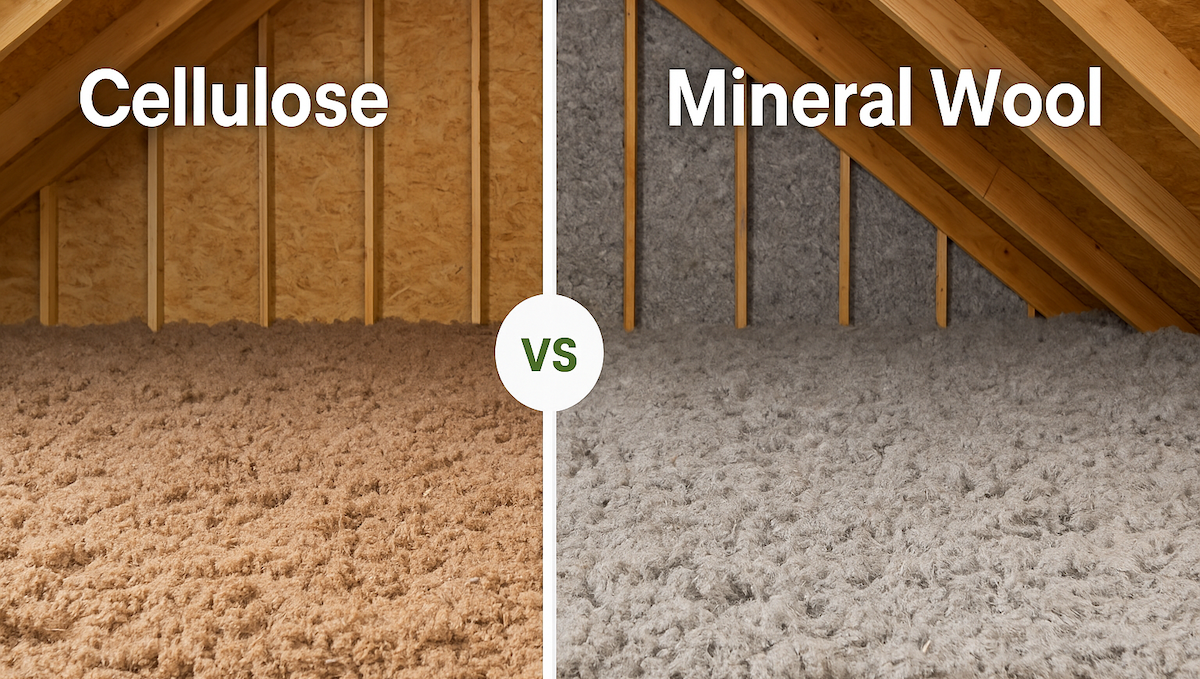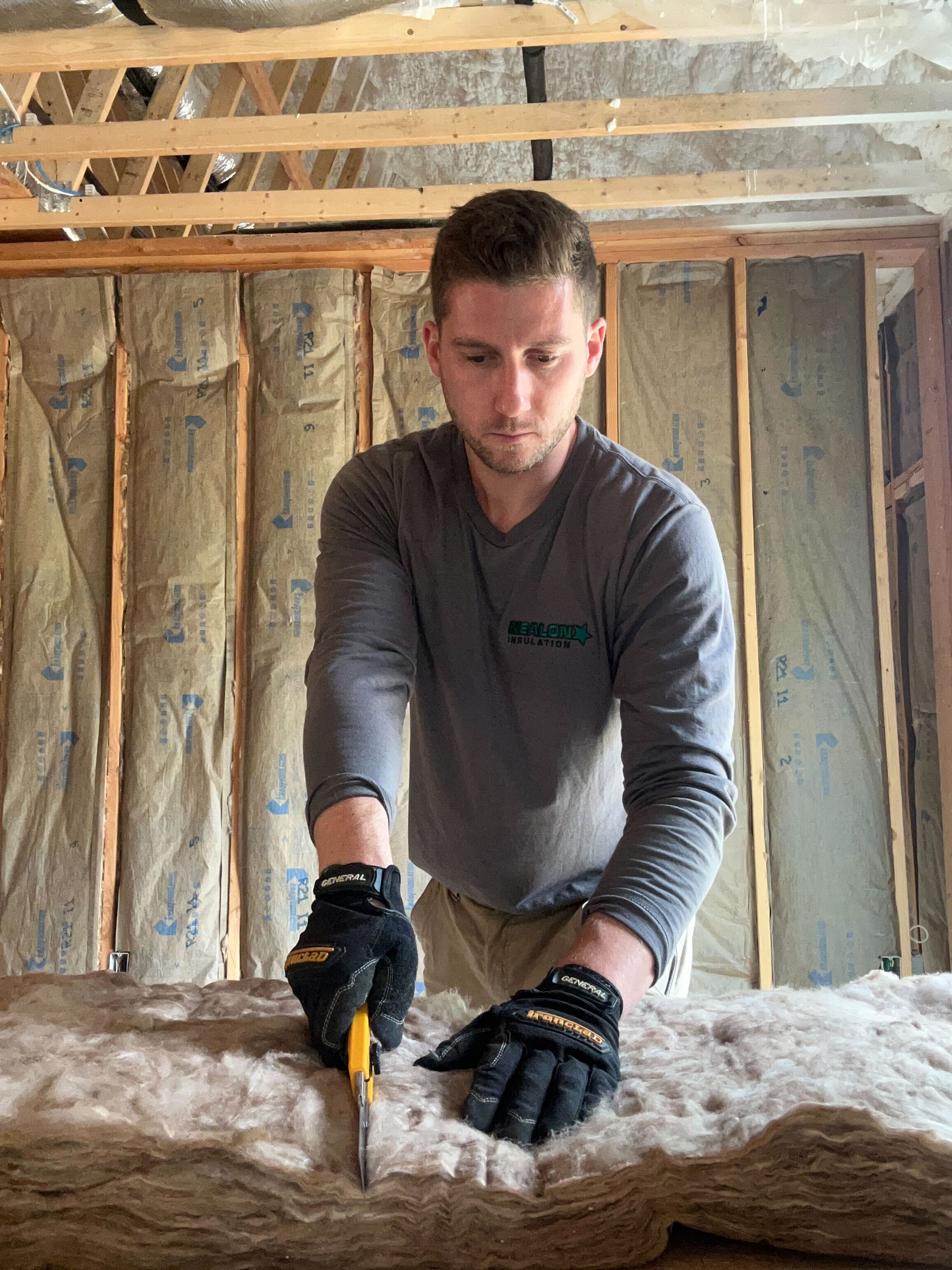Blown-In Mineral Wool vs Cellulose: The Honest Guide for Connecticut Homes

If you’ve ever stood in your attic staring at that sea of insulation and thought, “Should I go cellulose or mineral wool this time?” — you’re not alone. These two are the heavyweights of the blown-in insulation world, and both have a loyal fan base ready to throw punches over R-values and fire resistance.
But let’s keep it simple.
This isn’t about starting a material war, it’s about finding the right fit for your home, your budget, and your climate. Whether you’re fighting winter drafts in Guilford or trying to keep a shoreline house dry in Old Saybrook, choosing between blown-in mineral wool vs cellulose insulation can make a real difference in comfort and energy bills.
In this guide, we’ll break down what each material is made of, how they perform in real-world conditions, and where each one shines (or falls short). By the end, you’ll know exactly which insulation type deserves a place in your walls—or your wallet.
What Is Blown-In Insulation (and Why It Matters)
Before we get into the mineral wool vs cellulose showdown, let’s cover what “blown-in” actually means.
Unlike fiberglass batts that come in big, itchy rolls, blown-in insulation is a loose, fluffy material that’s literally blown into place using a hose. Think of it like filling every nook and cranny of your attic or wall cavities with millions of tiny insulation particles. It’s fast, it’s thorough, and it seals up gaps that traditional insulation often misses.
Blown-in insulation works great for:
- Attics: It covers joists and uneven spaces with uniform depth.
- Walls: Installers drill small holes, fill each cavity under pressure, and patch it cleanly after.
- Crawl spaces and rim joists: Hard-to-reach areas that still need solid R-value protection.
The big advantage? It’s adaptable. Whether you’re retrofitting an older Connecticut home or tightening up a newer one, blown-in insulation improves comfort and efficiency without major demolition.
There are a few materials you can “blow in”; cellulose, fiberglass, and mineral wool are the most common. Today we’re zooming in on the two homeowners ask about most: blown-in mineral wool vs cellulose insulation.
Meet the Contenders: Mineral Wool and Cellulose
Every good matchup needs a proper introduction. In one corner, we’ve got cellulose insulation, the scrappy, eco-friendly veteran made from recycled paper. In the other, mineral wool insulation, the tough, rock-solid contender born from melted stone.
Let’s get to know what makes each one tick.
What Is Cellulose Insulation?
Cellulose is the definition of “old-school done right.” It’s made from shredded newspaper and cardboard treated with non-toxic fire retardants—usually borate. When blown into your attic or walls, it forms a dense, continuous blanket that blocks air movement and heat loss.
Why homeowners love it:
- It’s one of the greenest insulation materials available (up to 85% recycled content).
- It’s excellent for draft control—especially in older homes with leaky walls.
- It’s affordable, fast to install, and delivers steady energy savings year-round.
Think of cellulose as the insulation version of a good winter coat: soft, flexible, and really good at keeping the warmth in.
What Is Mineral Wool (Rockwool) Insulation?
Mineral wool, sometimes called rockwool, is made by melting down basalt rock or industrial slag, then spinning it into fibers. The result looks a bit like cotton candy made of stone (minus the fun colors).
Why it’s a favorite among pros:
- It’s naturally fireproof, withstanding temperatures up to 2,000°F.
- It repels moisture and resists mold—ideal for basements, rim joists, or coastal climates.
- It’s incredibly durable—once installed, it won’t settle or sag.
If cellulose is the winter coat, mineral wool is the fireproof armor. It’s tougher, pricier, and built to last a lifetime, but not every home needs that level of protection.
Head-to-Head Comparison: Cellulose vs Mineral Wool
Alright, time to roll up our sleeves. Both blown-in cellulose and mineral wool have their strengths—but they perform differently when it comes to comfort, cost, and durability.
Here’s how they stack up in the real world:
Quick Takeaway:
- Cellulose is the champ for homeowners who want eco-friendly comfort and solid air sealing at a fair price.
- Mineral wool is the rugged choice for anyone prioritizing fire safety, durability, and moisture control.
In other words: cellulose keeps you warm and saves you cash, while mineral wool keeps you protected and dry.
Performance Breakdown (Where Each Wins)
What looks good on paper doesn’t always translate to comfort once it’s in your walls. Here’s how blown-in mineral wool vs cellulose insulation stack up where it really matters.
Energy Efficiency and R-Value:
- Cellulose: R-3.5 to R-3.8 per inch
- Mineral Wool: R-4.0 to R-4.3 per inch
Mineral wool wins by the numbers, but cellulose seals air leaks more effectively—so in real-world conditions, it often performs just as well.
Fire and Moisture Resistance:
- Mineral wool can handle 2,000°F and shrug off moisture, making it ideal for Connecticut basements or shoreline homes.
- Cellulose performs well when kept dry but loses strength if soaked.
Soundproofing:
- Both shine here. Their dense fibers absorb sound, turning noisy rooms into peaceful ones.
Durability:
- Mineral wool never settles. Cellulose can, but dense-pack installation prevents that.
Verdict:
- Cellulose: best for tight air sealing and efficiency.
- Mineral wool: best for fire, moisture, and longevity.
Cost and Installation Factors
Let’s talk dollars and dust.
Cost:
- Cellulose: $2.50–$3.00 per sq. ft. installed
- Mineral Wool: $3.75–$4.25 per sq. ft. installed
Cellulose wins on upfront value. Mineral wool costs more but pays back with durability and safety.
Installation:
- Both use blowing equipment, but density differs: cellulose is tightly packed to air-seal, mineral wool is lighter and springier. Either way, professional installation is key—uneven coverage wastes your investment.
Longevity:
- Cellulose may settle slightly, while mineral wool stays rock-solid for decades.
Bottom line:
- If you want maximum performance per dollar, go cellulose.
- If you want peace of mind in tough conditions, go mineral wool.
Environmental and Health Considerations
Cellulose: Made from 85% recycled paper, low-energy manufacturing, borate-treated for fire and pest resistance. Fully recyclable and biodegradable.
Mineral Wool: Made from rock and slag, higher manufacturing energy but lasts for generations. No off-gassing, non-toxic, and mold-resistant.
Both materials are safe, formaldehyde-free, and excellent for indoor air quality.
Verdict:
- Cellulose: greener to produce.
- Mineral wool: greener to keep.
Which Insulation Is Best for Connecticut Homes?
Connecticut weather keeps you guessing—cold snaps, humid summers, salty air. Here’s the local take:
Attics and older homes: go cellulose for dense coverage and draft control.
Basements and rim joists: go mineral wool for moisture and mold resistance.
Newer homes or full upgrades: mix both—cellulose for open areas, mineral wool for problem zones.
Summary:
- Cellulose: best for retrofits and cost efficiency.
- Mineral Wool: best for durability and moisture-prone spaces.
Either way, both beat fiberglass by a long shot.
Final Verdict: You Can’t Go Wrong with Professional Guidance
Here’s the truth: both cellulose and mineral wool perform beautifully when installed correctly—and both fail when they’re not.
- Choose cellulose if you want an eco-friendly, budget-friendly solution that seals air and saves energy.
- Choose mineral wool if you want long-term durability, fire protection, and resistance to moisture.
But don’t sweat the decision too much—let a pro evaluate your home and help you get it right the first time.
👉 Still unsure which blown-in insulation makes sense for your home?
Contact Nealon Insulation for a free, no-pressure consultation. We’ll walk your attic, check your R-values, and help you choose the right material—installed the right way—for year-round comfort and savings.
Common FAQ's about Mineral Wool vs Cellulose
Is blown-in mineral wool or cellulose better for soundproofing interior walls?
Cellulose offers slightly better soundproofing than mineral wool due to its higher density and superior acoustic absorption. However, mineral wool blocks high-frequency sounds more effectively and provides better fire resistance. Both materials greatly reduce noise transfer compared to fiberglass or open wall cavities.
Is mineral wool safer than cellulose insulation in terms of fire protection?
Mineral wool is safer than cellulose insulation for fire protection. Made from stone or slag, it is noncombustible and can withstand temperatures up to 2,000°F. Cellulose contains fire retardants but can still char when exposed to flames. For maximum fire safety, mineral wool provides superior resistance.
Does mineral wool or cellulose have a higher R-value per inch?
Mineral wool has a higher R-value per inch, averaging R-4.0 to R-4.3, while cellulose ranges from R-3.5 to R-3.8. In practice, the difference is minor. Properly installed cellulose performs comparably due to its density, which limits air movement and maintains energy efficiency when air sealed.
Does cellulose or mineral wool handle moisture better?
Mineral wool handles moisture better than cellulose. It is water-repellent and mold-resistant, so it won’t absorb or retain moisture from leaks or condensation. Cellulose absorbs water easily, lowering its R-value until dry. For humid or coastal areas, mineral wool provides longer-lasting moisture protection.
Is cellulose insulation more environmentally friendly than mineral wool?
Cellulose insulation is more environmentally friendly than mineral wool. Made from up to 85% recycled paper, it requires minimal manufacturing energy and diverts waste from landfills. While mineral wool uses natural rock or slag, it consumes more energy to produce. Cellulose offers the lowest carbon footprint overall.
Which insulation is more cost-effective for Connecticut homeowners?
For Connecticut homeowners, cellulose insulation is more cost-effective than mineral wool. It costs 30–60% less to install and provides strong energy savings per dollar, ideal for attics and wall retrofits. Mineral wool costs more but offers superior fire and moisture resistance, making it better for long-term durability.
Related Articles
Let's Work Together
Ready to transform your home into an energy-efficient haven? Schedule your free energy assessment today and experience the Nealon difference for yourself.



